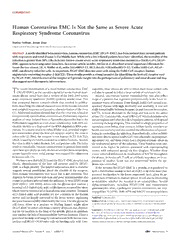
Human Coronavirus EMC Is Not the Same as Severe Acute Respiratory Syndrome Coronavirus. PDF
Preview Human Coronavirus EMC Is Not the Same as Severe Acute Respiratory Syndrome Coronavirus.
COMMENTARY Human Coronavirus EMC Is Not the Same as Severe Acute Respiratory Syndrome Coronavirus StanleyPerlman,JincunZhao DepartmentofMicrobiology,UniversityofIowa,IowaCity,Iowa,USA ABSTRACT Anewlyidentifiedbetacoronavirus,humancoronavirusEMC(HCoV-EMC),hasbeenisolatedfromseveralpatients withrespiratoryandrenaldiseaseintheMiddleEast.Whileonlyafewinfectedpatientshavebeenidentified,themortalityofthe infectionisgreaterthan50%.Likeitsbetter-knowncousinsevereacuterespiratorysyndromecoronavirus(SARS-CoV),HCoV- EMCappearstohaveoriginatedfrombats.InarecentarticleinmBio,Mülleretal.describedseveralimportantdifferencesbe- tweenthetwoviruses[M.A.Mülleretal.,mBio3(6):e00515-12,2012,doi:10.1128/mBio.00515-12].UnlikeSARS-CoV,HCoV- EMCcandirectlyinfectbatcells.Asimportant,HCoV-EMCdoesnotentercellsusingtheSARS-CoVreceptor,human angiotensin-convertingreceptor-2(hACE2).Theseresultsprovideastrongincentiveforidentifyingthehostcellreceptorused byHCoV-EMC.Identificationofthereceptorwillprovideinsightintothepathogenesisofpulmonaryandrenaldiseaseandmay alsosuggestnoveltherapeuticinterventions. Therecentidentificationofanovelhumancoronavirus,EMC sequently,thesevirusesareabletoinfectmosttissueculturecells (HCoV-EMC),asthecausativeagentforseverehumanrespi- andalsotospreadtoinfectalargevarietyofruminants(4). ratorydiseaseraisedfearsthataversionofthe2002-2003severe Second, uncommon human transmissibility may also reflect acuterespiratorysyndrome(SARS)epidemicwouldrecur.This usageofaproteinthatispresentpredominantlyinthelowerre- fear prompted intense research efforts that resulted in publica- spiratorytractsofhumans.EventhoughSARS-CoVcausedare- tionsdescribingtheclinicalcharacteristicsofthehumaninfection spiratory disease with high morbidity and mortality, it was not andcompletesequenceandgenomiccharacterizationofthevirus easilytransmissiblebetweenhumans,inpartbecauseitsreceptor, (1).Additionalanalysesshowedthatthattheviruswasrelatedto hACE2, is most abundant in the lungs and less so in the upper twopreviouslyidentifiedbatcoronaviruses.Preliminarysequence airway(5).Consequently,mostSARS-CoV-infectedpatientswere analysisofvirusisolatedfromaPipistrelluspipistrellusbatinthe notcontagiousuntilaftertheydevelopedpneumonia,withspread Netherlandssuggestedanevencloserrelationship,with88%nu- occurringvialargedroplets.Thisresultedinahighproportionof cleotideidentitytoafragmentoftheRNA-dependentRNApoly- secondary cases being close contacts (either family members or merase.InarecentarticleinmBio,Mülleretal.providedimpor- healthcareworkers)andalsoenabledtheeffectivenessofquaran- tantinformationaboutthehostcellreceptorusedbythevirusto tiningincontrollingtheinfection.Parenthetically,afewindivid- infectcells(2).First,thereceptorisnothumanACE2(hACE2), ualswereabletospreadSARS-CoVveryefficiently(superspread- whichisusedbytheSARScoronavirustoinfecthumans.Second, ingevents)(6),andtheseeventshadadisproportionateeffecton thevirusisabletoinfecthuman,bat,andporcinecells.Thelatter thewidespreadnatureoftheinfection.Virusburdenswerepre- resultisremarkable,becausecoronavirusesingeneralshowfairly sumed to be higher in patients associated with superspreading stricthostspecificity;inearlystudiesofanotherbetacoronavirus, events, with enhanced spread via fine droplets. Whether these mousehepatitisvirus,serialpassagewasrequiredforadaptation eventsreflecteddifferencesinlocalizationofhACE2throughout tohumancells(3). theairway,ininnatecell,Tcell,orantibodyresponses,orinex- WeknownowthathACE2isnottheHCoV-EMCreceptor,but pression of another factor was not determined before the epi- clearly, identification of the host cell receptor used by HCoV- demicwascontrolled. EMCisahighpriority.Thelimitedinformationthatisavailable IfthereceptorforHCoV-EMCisaprotein,itispredictedto suggests several possibilities about the identity of the receptor. haveadistributionsimilartothatofACE2oranevenmorepro- First, human transmission may occur but is not common. This nouncedlocalizationtothelowerrespiratorytract,givenitsap- disparitybetweensevereinfectionandpoortransmissibilityalso parentlackofhuman-to-humanspread.Itwillalsobeinteresting occursinpatientsinfectedwiththeinfluenzaAvirusH5N1strain to determine whether the receptor is an ectopeptidase. Several (IAV-H5N1). IAV-H5N1 enters cells via glycans that contain a alphacoronaviruses, including HCoV-229E and transmissible terminal(cid:1)2,3-linkedsialicacid,unlikehumanstrainsofthevirus, gastroenteritisvirus,apathogenicporcinecoronavirus,useami- whichbindtoterminal(cid:1)2,6-linkedsialicacidmoieties.Terminal nopeptidaseN(APN).BothAPNandhACE2areectopeptidases (cid:1)2,3-linked sialic acid proteins are not common in the human airwayandarelargelyrestrictedtothelowerairway,explaining Published15January2013 thepoortransmissibilityexhibitedbythevirus.Useofaglycanfor CitationPerlmanS,ZhaoJ.2013.HumancoronavirusEMCisnotthesameassevere cell entry, either as a primary or binding ligand, might allow acuterespiratorysyndromecoronavirus.mBio4(1):e00002-13.doi:10.1128/mBio.00002- 13. HCoV-EMCtoinfectcellsfromavarietyofspeciesand,depend- Copyright©2013PerlmanandZhaoThisisanopen-accessarticledistributedunder ingonthelocationinthelungofthespecificglycaninquestion, thetermsoftheCreativeCommonsAttribution-Noncommercial-ShareAlike3.0 mayexplainthelackoftransmissibilitybetweenhumans.Thereis Unportedlicense,whichpermitsunrestrictednoncommercialuse,distribution,and precedentforsialicacidusagebycoronaviruses:bothbovinecoro- reproductioninanymedium,providedtheoriginalauthorandsourcearecredited. navirusandHCoV-OC43entercellsviabindingsialicacid.Con- AddresscorrespondencetoStanleyPerlman,[email protected]. January/February2013 Volume4 Issue1 e00002-13 ® mbio.asm.org 1 Commentary andcleaveN-terminalaminoacidsfromsmallpeptides.However, resultinclinicaldisease.This,inturn,mayresultinnovelthera- inneitherinstanceistheenzymaticactivityoftheproteinrequired peuticinterventionstodiminishimmunopathologicaldisease. forreceptorfunction,suggestingthatthestructureoftheectodo- Whileidentificationofthereceptorwillbeanimportantad- mainofeachmoleculeisespeciallyamenabletocoronavirusbind- vance,theoverarchingquestionatpresentiswhetherHCoV-EMC ing.InadditiontoservingasthereceptorforSARS-CoV,ACE2 isorwillbecomeanimportanthumanpathogen.Atthispoint, haslung-protectiveproperties.DownregulationofACE2,asoc- fewerthan10caseshavebeenidentifiedandthemortalityratehas curs during SARS-CoV infection, is believed to contribute to beengreaterthan50%.Withsofewcases,infectionandanalysisof pathologicalchangesinthelung(7).Itwillbeofinteresttodeter- laboratoryanimalswillberequiredtofulfillKoch’spostulatesand mineifthereceptorforHCoV-EMChassimilarproperties. prove a causative role for HCoV-EMC in respiratory disease. If Identificationofthereceptormayalsoshedlightonapoten- HCoV-EMCisassociatedwithrespiratorydiseaseinanimals,as tially novel aspect of HCoV-EMC pathogenesis. Initial reports seemslikely,epidemiologicalstudiestoprovideadenominatorfor thetotalnumberofcaseswillbeessential.IsHCoV-EMCacom- suggestthatrenalfailureispartofthediseaseprocess(8),although moninfectionintheMiddleEast,withmostpatientsremaining atthispointitisimpossibletoknowwhetherthisisaspecificeffect asymptomaticordevelopingmilddisease,oristheinfectionrare, or a consequence of the multiorgan failure that often occurs in butwheninfectionoccurs,diseaseissevere?Developmentoftools severelyillpatients.Ifkidneyinvolvementisdocumentedinmost todetectpastandpresentinfectionsiscriticalandwillbefacili- patients,identificationoftheHCoV-EMCreceptormayprovidea tated by recent publications of the virus sequence and genomic basisforunderstandingwhyrenaldiseaseiscommon.TheSARS- analysis.Equallyimportantwillbethecollectionandanalysisof CoVreceptor,ACE2,ispresentathighlevelsinthehumankidney, samplesfromrepresentativepopulationsintheMiddleEast.Most andSARS-CoVwasdetectedinthekidneysofsomepatientsdur- patientsinfectedwithSARS-CoVdevelopedclinicaldisease,with ingthe2002-2003epidemic,butrenaldiseasedidnotoccurcom- onlyafewinfectionsremainingasymptomatic.IfHCoV-EMCisa monly during the infection (5). Understanding the differential newpathogen,willitfurtheradapttohumanpopulations,asthe abilitiesofHCoV-EMCandSARS-CoVtocauserenaldiseasewill SARS-CoVdidduringthe2002-2003epidemic(4,6)?Ifvirusis provideinsightintoauniqueaspectoftheHCoV-EMCinfection. detectedonlyrarelyinhumanpopulationsandneverspreadssig- Ofnote,coronavirusinfectionoftherespiratorytractandrenal nificantlyfromhumantohuman,itmaynotbeamajorhealth systemhasbeendescribedinchickensinfectedwithanothercoro- issue,buttheinterestingquestionofhowtheseunluckyindividu- navirus,infectiousbronchitisvirus(IBV)(9).IBVisbestknownas alswereinfectedremainstobeaddressed. animportantcausativeagentforupperrespiratorytractdiseasein youngchickens,butstrainsthatalsoinfectthekidneyhavebeen REFERENCES identified.ThecellularreceptorforIBVhasnotbeenidentified,so 1. vanBoheemenS,deGraafM,LauberC,BestebroerTM,RajVS,Zaki therelationshipbetweenreceptorexpressionanddiseasefordif- AM, Osterhaus AD, Haagmans BL, Gorbalenya AE, Snijder EJ, FouchierRA.2012.Genomiccharacterizationofanewlydiscoveredcoro- ferentIBVstrainsremainsanareaofactiveinvestigation. navirusassociatedwithacuterespiratorydistresssyndromeinhumans. Finally, Müller et al. demonstrated infection of bat-derived mBio3(6):-12.http://dx.doi.org/10.1128/mBio.00473-1200473. cultured cells, raising the possibility that HCoV-EMC jumped 2. MullerMA,RajVS,MuthD,MeyerB,KalliesS,SmitsSL,WollnyR, speciesdirectlyfrombatstohumans.Thisalsosuggeststhatthe Bestebroer TM, Specht S, Suliman T, Zimmermann K, Binger T, EckerleI,TschapkaM,ZakiAM,OsterhausAD,FouchierRA,Haag- hostcellreceptor,ifaprotein,issufficientlysimilarbetweenhu- mansBL,DrostenC.2012.HumancoronavirusEMCdoesnotrequire mansandbatstofacilitatedirecttransmission.Batsarerecognized theSARS-coronavirusreceptorandmaintainsbroadreplicativecapability askeyreservoirsforviruses,includingseveralcoronavirusesand inmammaliancelllines.mBio3(6):-12.http://dx.doi.org/10.1128/mBio henipaviruses, such as Nipah virus and Hendra virus (5). In all .00515-1200515. 3. Baric RS, Sullivan E, Hensley L, Yount B, Chen W. 1999. Persistent cases,batsdonotappeartodevelopclinicaldisease,butdiseaseis infectionpromotescross-speciestransmissibilityofmousehepatitisvirus. severewhenvirusescrossovertoinfecthumanpopulations.This J.Virol.73:638–649. is analogous to the situation in humans and sooty mangabeys 4. PerlmanS,NetlandJ.2009.Coronavirusespost-SARS:updateonrepli- cationandpathogenesis.Nat.Rev.Microbiol.7:439–450. infected with human immunodeficiency virus (HIV) and the 5. ChenJ,SubbaraoK.2007.TheimmunobiologyofSARS.Annu.Rev. closelyrelatedsimianimmunodeficiencyvirus(SIV),respectively: Immunol.25:443–472. sootymangabeysinfectedwithSIVdonotdevelopsignificantdis- 6. PeirisJS,GuanY,YuenKY.2004.Severeacuterespiratorysyndrome. ease,whereasHIVisfatalinhumans(10).Acriticalquestionis Nat.Med.10(12Suppl):S88–S97. 7. ImaiY,KubaK,Ohto-NakanishiT,PenningerJM.2010.Angiotensin- why bats are “tolerant” of infections such as HCoV-EMC or convertingenzyme2(ACE2)indiseasepathogenesis.Circ.J.74:405–410. SARS-CoV.Howdotheycleartheviruswithoutdevelopingim- 8. Zaki AM, van Boheemen S, Bestebroer TM, Osterhaus AD, Fouchier munopathologicaldisease?Ifcoronavirus-infectedbatsaresimi- RA.2012.Isolationofanovelcoronavirusfromamanwithpneumoniain lartoSIV-infectedsootymangabeys,infectionmaynotactivate SaudiArabia.N.Engl.J.Med.367:1814–1820. 9. Perlman S, Dandekar AA. 2005. Immunopathogenesis of coronavirus thehostimmuneresponsetothesameextentasitdoesinhumans. infections:implicationsforSARS.Nat.Rev.Immunol.5:917–927. Understanding how bats respond to the infection may provide 10. ChahroudiA,BosingerSE,VanderfordTH,PaiardiniM,SilvestriG. insightintohowspecificaspectsofthehumanimmuneresponse 2012.NaturalSIVhosts:showingAIDSthedoor.Science335:1188–1193. TheviewsexpressedinthisCommentarydonotnecessarilyreflecttheviewsofthejournalorofASM. 2 ® mbio.asm.org January/February2013 Volume4 Issue1 e00002-13
